Ghana’s bushmeat butchers: 24 hours at the slaughter slab
Bushmeat, from wild animals captured for food, is a valuable source of protein in Ghana. But what health risks does it carry, and could it spread disease further afield? Yepoka Yeebo finds out.
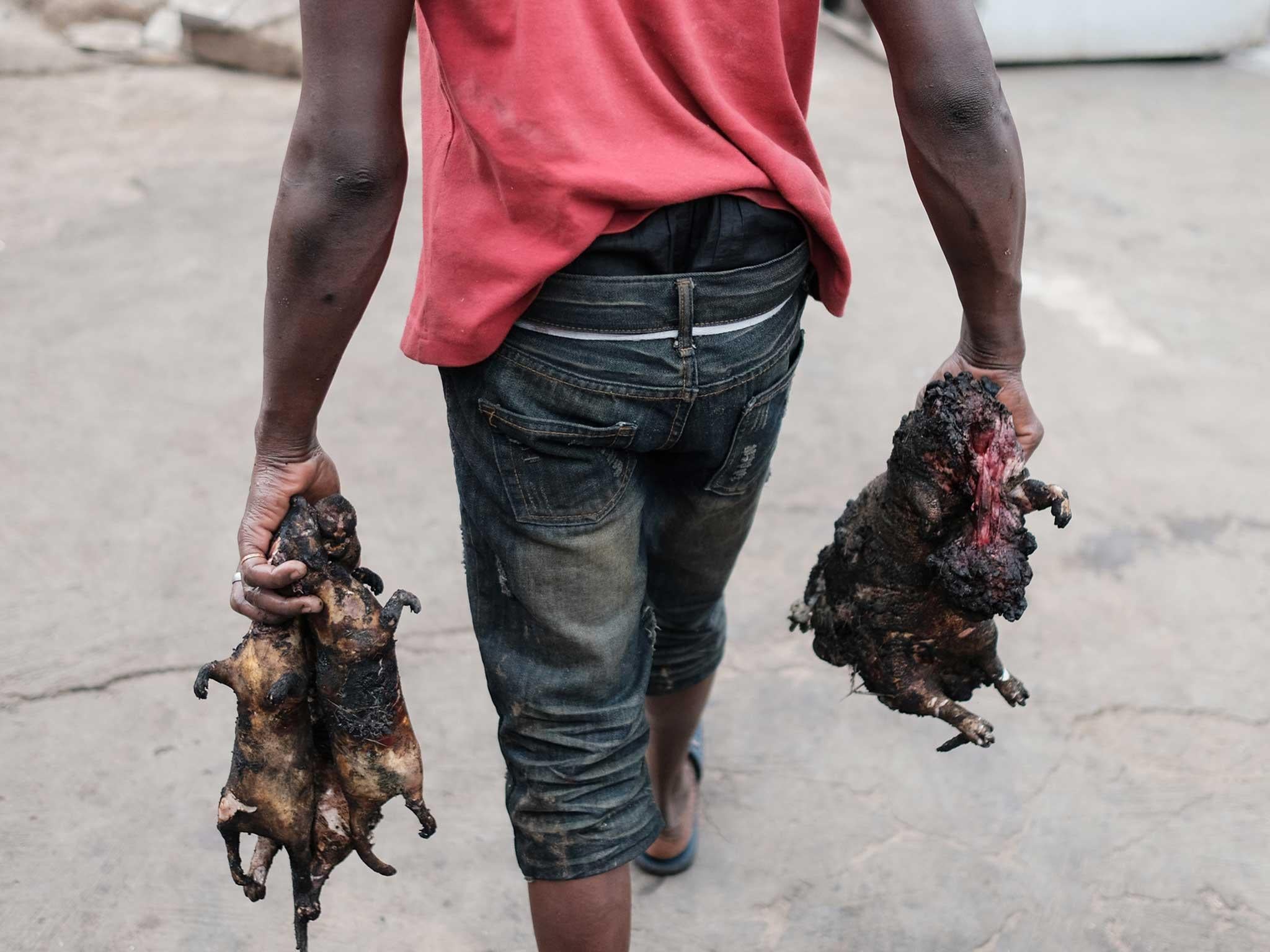
Your support helps us to tell the story
From reproductive rights to climate change to Big Tech, The Independent is on the ground when the story is developing. Whether it's investigating the financials of Elon Musk's pro-Trump PAC or producing our latest documentary, 'The A Word', which shines a light on the American women fighting for reproductive rights, we know how important it is to parse out the facts from the messaging.
At such a critical moment in US history, we need reporters on the ground. Your donation allows us to keep sending journalists to speak to both sides of the story.
The Independent is trusted by Americans across the entire political spectrum. And unlike many other quality news outlets, we choose not to lock Americans out of our reporting and analysis with paywalls. We believe quality journalism should be available to everyone, paid for by those who can afford it.
Your support makes all the difference.The antelope looked exactly like a cartoon deer. It had rust-coloured fur, white spots on its hindquarters and an oddly regal bearing. Its throat had been slit, and it had just been dumped, rather unceremoniously, on the hard-packed black earth of the burning area at Atwemonom, the open-air abattoir at the centre of Ghana’s commercial bushmeat trade.
The antelope – a female bushbuck – arrived at dawn in a white plastic sack out of a rickety van. It was delivered along with 15 grasscutters (greater cane rats, which look like large guinea pigs and are about a foot long), eight giant rats and two hares. The market woman supervising the delivery had the butchers count everything twice.
Once the audit was done, a butcher singed the fur off the creatures over an open fire, then hauled the carcasses over to the nearby slaughter slab. That, by the way, is something of a misnomer. All the wild game that finds its way to Atwemonom is already dead. Nothing actually gets slaughtered here apart from the occasional visibly anxious goat.
At the slaughter slab, the carcasses are scrubbed of singed fur and soot. Then, what happens next depends on the market woman who owns the meat. Some have it gutted and dressed. Some prefer to keep the carcasses whole, toss them in an industrial freezer and butcher them just before they’re sold.
Atwemonom is in Kumasi, Ghana’s second city. It’s about ten minutes from the Central Market. The abattoir sits by a road so choked with traffic that, for hours, nothing appears to move. That morning the meat market was a hive of activity. Women were setting up their stalls, laying out huge stainless steel bowls of whole grasscutter and small duiker antelope.
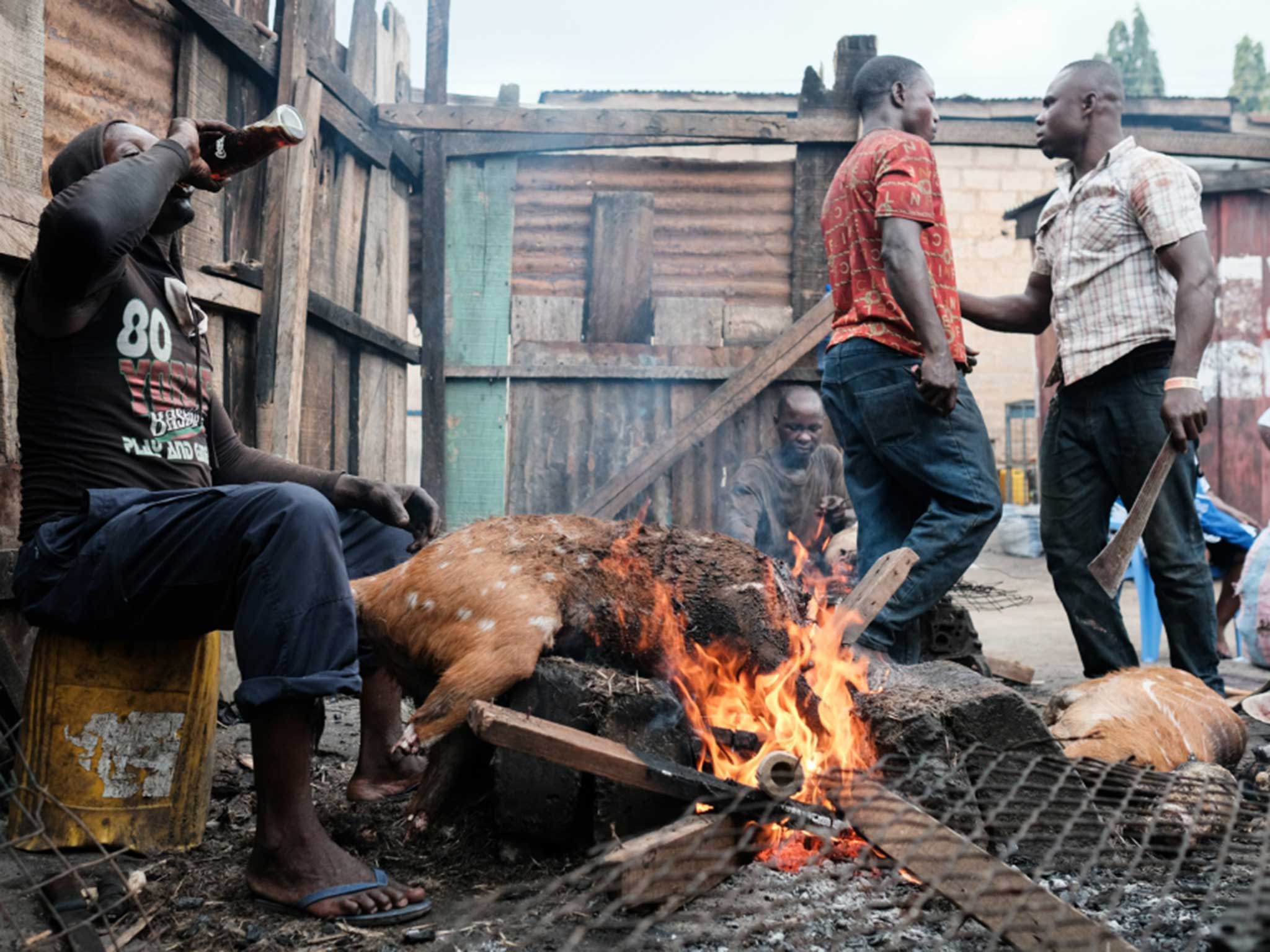
Beyond the slaughter slab is a small lane, a thoroughfare for everyone from hawkers selling ice lollies to foreign salesmen peddling blenders on the never-never. On that morning it was the prep area for a street-food hawker who was hunched over a pestle and mortar grinding peppers, tomatoes and onions into chilli sauce.
The smell of charred flesh drifted over from an enclosure of timber and zinc roofing sheets: the burning area. Inside, there was a low charcoal fire smouldering between two engine blocks. It was slowly smoking some grasscutter. This, the butcher said, was for someone who was planning on taking the meat back home to Europe.
Any wild animal from the countryside – the bush – that has been killed for food is bushmeat. It’s a contentious term. It remains unclear how the meat from the antelope delivered to Atwemonom is different from the wild venison being sold for extortionate prices in Knightsbridge in London. It’s also unclear why the term, from the French viande de brousse, is almost exclusively used to refer to wild game from West and Central Africa.
In these regions, as more and more of the bush has been cleared by loggers, miners and farmers, the population of wild animals has plunged. Some species are near extinction. As a result, hunters are forced further and further into nature reserves and other previously undisturbed areas. The problem is, the further people venture into the bush, the closer they come to possible reservoirs of infectious diseases. Around three-quarters of all new human diseases emerge from animals.
Bushmeat is a massive but poorly understood industry. How large is the market for bushmeat? Why is it such an important part of so many people’s diets? And could animal products from places like Atwemonom pose a threat to people around the world?
Hussein Iddrisu* has been burning and butchering bushmeat for a decade, after learning the trade from his father. He processes between 30 and 70 carcasses a day for the market women, who pay a fee for each batch. It’s hard work, he says. The fire is hot and the cutting takes muscle. If you’re not careful, you’ll get burned or slashed. On top of all that, business is down. A few years ago he wouldn’t have had the time to stop and chat. Now the hunters just aren’t sending as much meat from the bush.
He uses a machete to cut off the antelope’s head and three of its legs, before heaving the torso onto the fire, which starts to crackle. Another butcher takes over, rotating the carcass by its remaining leg with one bare hand, and scraping the charred fur off with the machete he holds in the other, sending a shower of scorched fur in every direction. You can smell the acrid odour of burning hair and flesh.
After about ten minutes, the rust-coloured fur is gone. The butcher heaves the carcass up onto his shoulder and carries it out of the burning area and across the lane, trailing the smell of freshly cooked meat and a raw, metallic tang. He dumps the steaming carcass onto the blood-spattered slaughter slab.
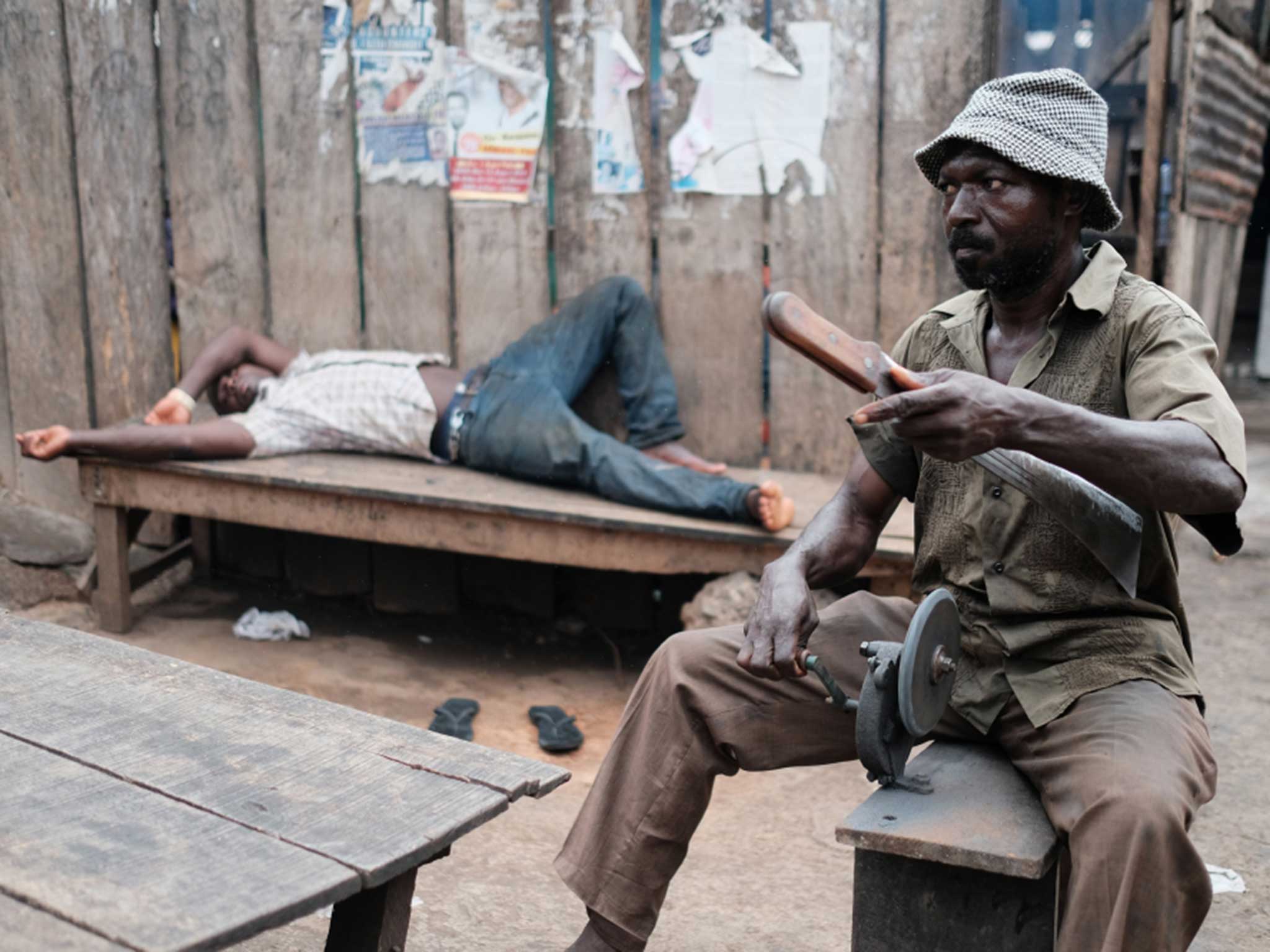
The bushmeat at Atwemonom comes from rural areas like Barekese (north of Kumasi), the road between Kumasi and Sunyani, and Konongo, which is on the way down to the capital Accra. Some is hunted as far away as the neighbouring Côte d’Ivoire.
The freshest specimens were caught during the darkest part of the night before, when the cane rats stepped on metal traps that snapped their necks, the antelope was shot and the hares caught the sharp end of a machete.
Forestry Commission inspector Moses Akologu is in charge of keeping track of the catches he encounters, recording the species, method of death, sex, weight and price of each, along with whether the specimen was pregnant and where it was hunted.
It is August, so Akologu is only counting the grasscutter that arrives at Atwemonom. Over 80 million greater cane rats are hunted in the region every year. Their population, he says, is pretty healthy: “Every three months, they give birth, and they can give birth to ten.”
Hunters will occasionally deliver protected species like hyena and pangolin. “If you bring it here and I catch you, I will seize it all for the government. They will send you to court,” says Akologu. The only sanction for illegal hunting is being fined a (usually modest) sum of money.
In Ghana, the Forestry Commission regulates hunting. They issue licences to hunters and permits to the market women who sell bushmeat. They also set hunting seasons, says David Kpelle, Tourism and Commercial Manager at the Wildlife Division, at his office in Accra.
When we speak it’s closed season, which runs from 1 August until 1 December. During this part of the year hunters are only supposed to go after grasscutter, which are farm pests.
During open season hunters can kill a rapidly shrinking list of species that are not on the endangered list (including bushbuck, duiker, civets, warthogs and squirrels). “There are animals which are not supposed to be hunted at any time. We have the lions, the elephants, the black-and-white colobus monkeys, the Diana monkeys – they are the ones that we consider as threatened species,” says Kpelle. Those animals have been heavily hunted, or have had their habitats destroyed by growing farms and logging roads.
To protect them, the Forestry Commission has established 16 reserves around the country. “But of course, wildlife knows no boundaries,” says Kpelle, and hunters don’t respect them, even going after elephants, he says – and not just for ivory. “The elephant is also good meat. The trunk is the best part.”
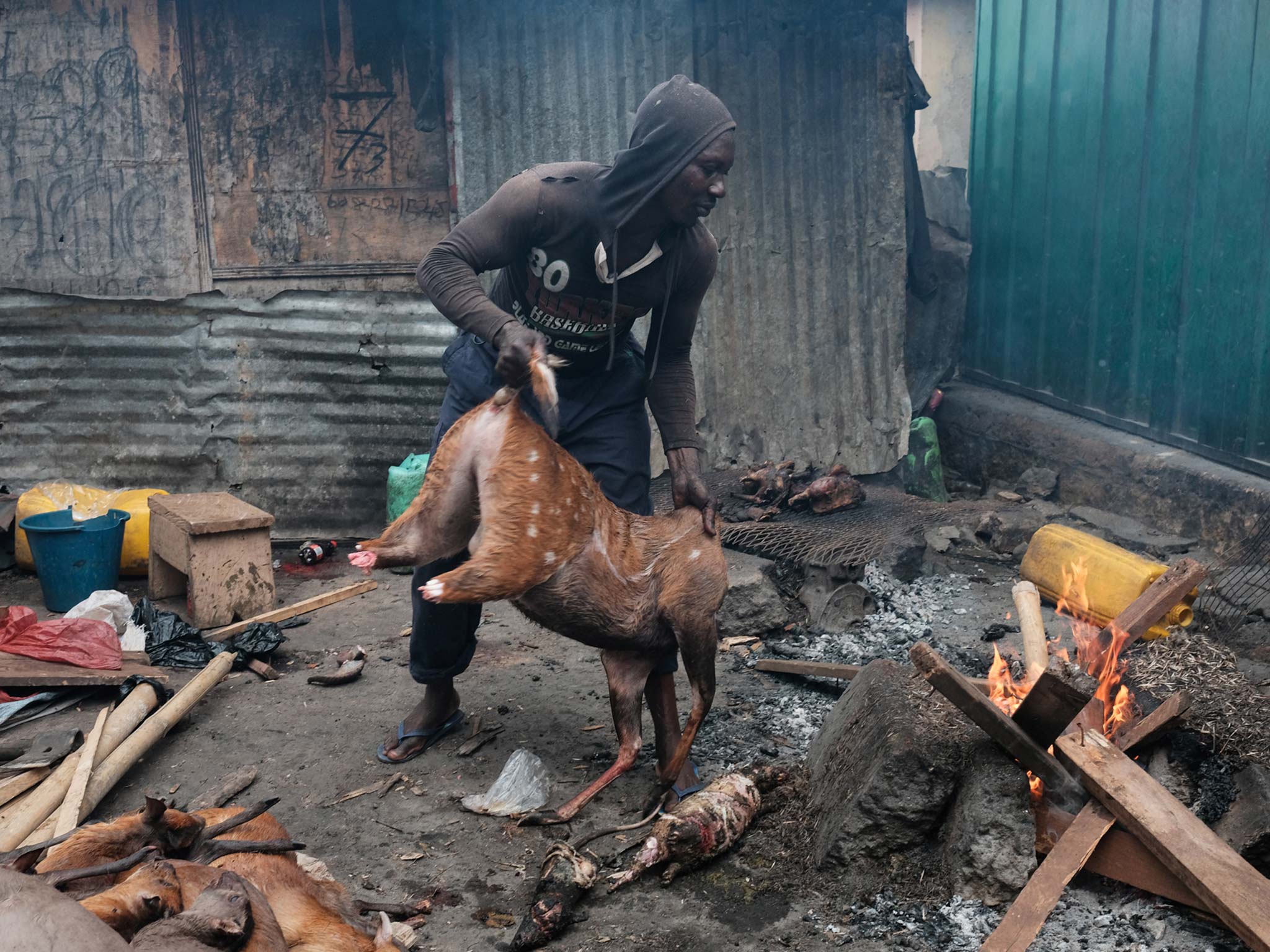
Ultimately, it’s hard to convince people that hunting needs to be stringently regulated: people have been eating bushmeat for generations, and there is evidence that demand for it may be growing in some quarters.
Climate change and illegal fishing by trawlers from other parts of the world mean Ghana’s fishing industry has all but collapsed. One researcher has found that when the catch falls, the amount of bushmeat on sale rises, Kpelle says. “Bushmeat is an important component of our dietary requirements in Ghana.”
Protein is vital for the developing bodies and minds of children. A lack of it has stunted millions in the region. Wild game, which has long been a source of protein, has remained essential in many places because it can be difficult to rear domesticated farm animals.
Parts of Ghana are prone to tsetse fly infestations, which cost cattle farmers in sub-Saharan Africa up to $12m (£9.2m) a year in losses. Fresh fish is only readily available near waterways or the shore. So Ghana imports an estimated 90 per cent of all meat sold in the country (about $200m of frozen chicken meat alone was brought in in 2013), which makes it relatively expensive.
In parts of Ghana, bushmeat is the freshest protein available. Farmers who would otherwise be struggling during the dry season can feed their families and bring in some extra income.
Some consumers in Ghana – like in many other parts of the world – are increasingly willing to shell out for healthy, natural foods. Because wild game tends to be lean, locally sourced and – connoisseurs swear – delicious, it has started to command a premium price in cities like Kumasi, where it is more expensive than beef or mutton. In Ghana alone, the bushmeat industry generates about £105m in revenue every year. For a lot of people, eating bushmeat is also about keeping traditions alive and maintaining a culture of living in harmony with nature that is rapidly being lost.
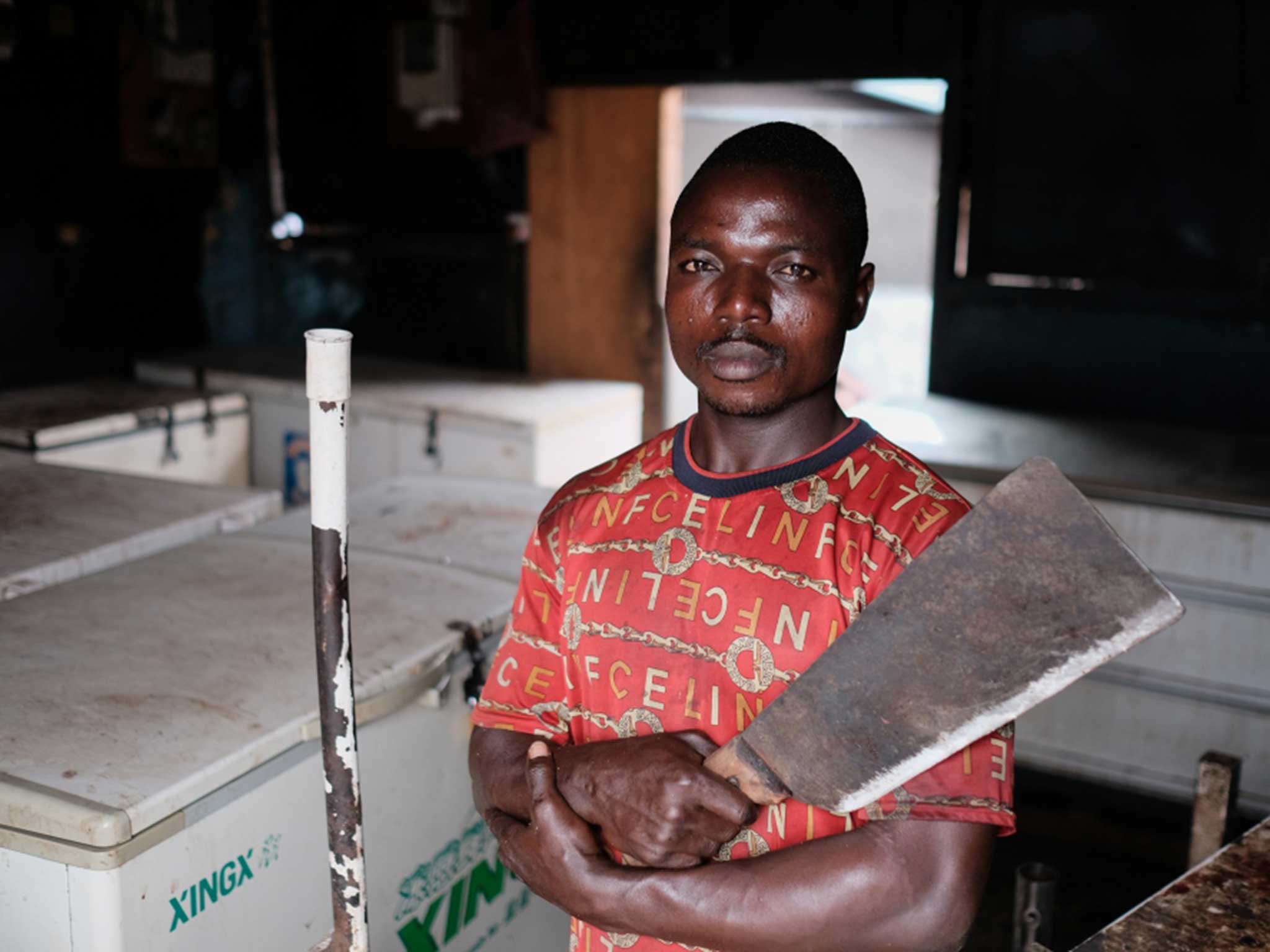
At Atwemonom, the butcher who deposited the antelope carcass at the slaughter slab starts to scrub it clean with a wire sponge and a basin of water. There are no taps and the water comes from yellow jerry cans filled up around the corner. The tiled concrete floor is slick with blood and water made murky by the soot from the singed carcasses. Another butcher sweeps up bits of flesh and offal. Behind him, a woman pours a bowl of blood over a low wall, sending the bluebottles that had settled on it into a frenzied cloud.
Once the bushbuck is clean, the butcher heaves the carcass back up on his shoulder and carries it past the burning area to a large wooden shed full of chest freezers. He dumps it in a blood-spattered deep-freeze, next to another antelope and a few grasscutters. The market woman is saving the animal for a day when business is brisker.
None of what I see at Atwemonom is any more objectionable than the events in a typical industrial abattoir anywhere in the world. Atwemonom is only notable because the blood, gore and carcasses are out in the open, in the market district of a big city.
The sheer amount of blood and other bodily fluids involved in processing meat can make it dangerous for the people involved. Although Atwemonom is a registered abattoir, there are few safety precautions on display.
“If you handle wild animals, you increase your risk of being exposed to whatever infectious agents there are, if there are any,” says Yaa Ntiamoa-Baidu, a professor of zoology at the University of Ghana, who has researched bushmeat in Ghana for decades. “But eating cooked bushmeat is different.”
“I do not think you going and buying a bowl of fufu with bushmeat exposes you to any diseases,” she says. Unless, of course, the food wasn’t properly cooked, which can apply to any meat.
Most of the market women who run the bushmeat trade are generations deep in the business. Atwemonom is run by two veterans, market queens Abena Akoto* and Mercy Acheampong*. Acheampong graduated from school in 1969, and went on to work at her parents’ chop bar. Chop bars are eateries – usually with plastic chairs, low tables and huge portions – that specialise in regional, just-like-mama-made-it dishes (chop means “to eat” in West African Pidgin English). Acheampong’s parents’ chop bar used to be right there at the market, back when the area was basically a marsh next to a cemetery. Even then, it was known for its bushmeat: the name Atwemonom is a compound word in Twi – the language of Kumasi and the surrounding region – that translates roughly as “fresh antelope”.
Acheampong ran a bushmeat stall down the hill in the Central Market before coming back up to the abattoir about two decades ago. Business was great back then. There was a healthy supply of bushmeat and a constant stream of customers. Then, a couple of years ago, all that changed. “Nobody came here to buy,” says Acheampong. “Ebola collapsed the business totally.”
Public health officials didn’t mean to tell people to stop eating bushmeat. “The whole world was in a state of panic. The first messages were wrong signals,” says Dr Bashiru Boi Kikimoto, Head of Public Health at Ghana’s Veterinary Services Department. “They said: ‘If you eat bushmeat, you are going to get Ebola,’ instead of going further to explain which type of bushmeat.”
What they should have said was that if you come into contact with a dead monkey or a dead bat, you are at risk, says Kikimoto. “But they lumped all the wild animals together, and caused a lot of panic.”
Viruses have likely been passing from animals to humans for millennia. In the last half-century alone, virologists and epidemiologists have been tracking a deadly litany including bird flu, SARS, HIV and Ebola.
The 2013 West African Ebola epidemic probably originated when a two-year-old boy in rural Guinea played with a fruit bat, fell ill and died two days later (fruit bats are thought to be the reservoir for the Ebola virus). Globally, 11,325 people have died, most of them in Guinea, Sierra Leone and Liberia. There were no recorded cases of Ebola in Ghana, but it’s impossible to overstate just how terrified people were that the country was next.
Fruit bats are as common as birds in Ghana. The straw-coloured creatures are a delicacy in parts of the country and an estimated 128,000 are eaten every year. They can migrate by as much as 2,500 km, and Ebola antibodies have been found in bats in rural Ghana. However, for decades people have been coming into contact with colonies of the bats in cities, with no documented outbreaks of Ebola.
Health officials decided to tell people to avoid contact with animals that are thought to transmit Ebola: bats, monkeys and antelope. If they had to touch them, people were told they should use protective gear. If they were going to eat any other bushmeat, they needed to cook it thoroughly. Five minutes of boiling kills the vast majority of pathogens found in food.
Most of the bushmeat commonly eaten in Ghana was not likely to be infected, Kikimoto says – grasscutter, for example, is not thought to transmit Ebola. Once his message was translated into Ghana’s more than 250 languages and dialects, however, it had been simplified to “don’t eat bushmeat”.
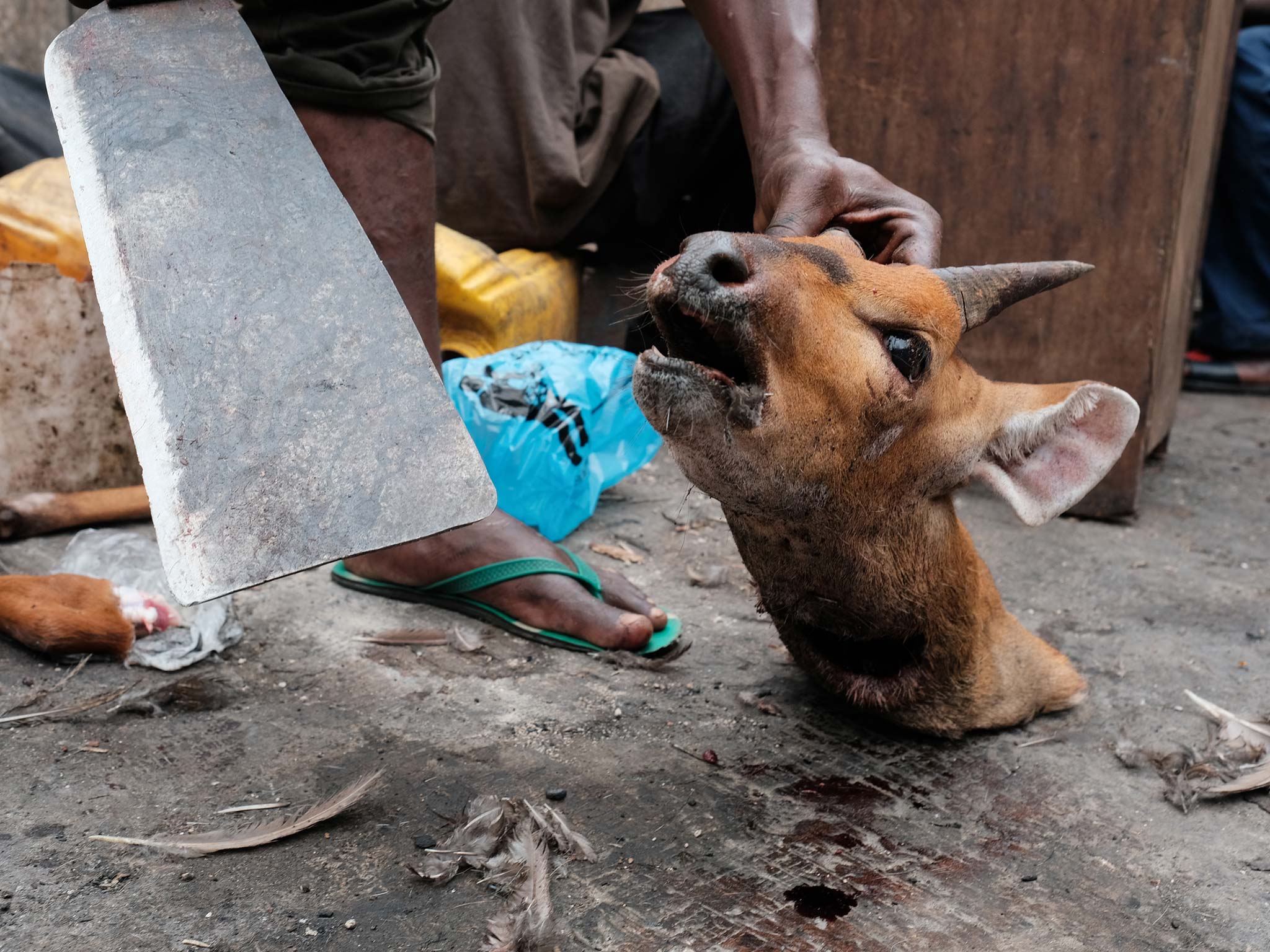
Most bushmeat is more likely to give you garden-variety food poisoning, says Kikimoto. Grasscutter is known to carry about 40 zoonotic pathogens, including parasites, bacteria, viruses and fungi. But even fish, he says, can carry about 15 zoonotic pathogens, including Salmonella and E. coli.
“The thing that is saving us is the way that we cook our meat,” says Kikimoto. “There are few highly thermo-resistant bacteria.” Ghanaian soups and stews tend to be boiled and simmered for hours, while smoked bushmeat reaches high temperatures and is then cooked a second time. Nobody eats their antelope rare.
One of the market women at Atwemonom is butchering the bright red meat of an African civet. They’re long, cat-like creatures with brown spotted fur, famed for the expensive coffee made using coffee beans they eat and excrete. The woman cuts the meat into smaller chunks while her assistant packs them into clear plastic bags for a customer who is buying 40 cedis (about £7.50) worth.
When the assistant is done, she takes the lid off a bright blue bucket. It is filled with the dark green, fibrous stomach contents of several grasscutters. She scoops some into a plastic bag. The stomach contents come free with every order of meat. The paste is said to give soup a distinct, fresh-from-the-bush aroma.
At the market’s chop bar, the bushmeat soup flavoured with these stomach contents is the most popular dish. The restaurant, run by Efia Konadu*, sends out a constant stream of savoury aromas: rich, oily palm nut soup, then earthy, peanutty groundnut soup.
The kitchen is out in the open, with women washing plates in one corner, and pairs of people pounding cassava and plantain into industrial quantities of the West African staple fufu behind a low wall. Chop bars are where most Ghanaians get their wild game, providing 85 per cent of the bushmeat sold to the public.
At the other end of the market, two men wearing dress shirts, ties and matching cufflinks are buying bushbuck and grasscutter (known as akrantie in Twi). “We’re making light soup, or you can call it akrantie soup,” says Dominic Erasmus.
The men say they are spending 250 cedis (under £50) on about 10 kilograms of meat, and are trying to get the market woman to throw in a couple of free cuts. As she scoops grasscutter stomach contents into a plastic bag, Erasmus says: “In akrantie, we don’t throw anything away, except the fur.”
Erasmus, who works as a medical administrator, thinks it’s safe to eat bushmeat: “We don’t think there’s any danger,” he says, “and we’re health workers.”
So what do we know about the risks? In the 1980s, Dr Donald Burke went in search of a vaccine for HIV. Burke, who was then the chief virologist at the Walter Reed Army Institute of Research, had collected different strains of HIV from all over the world. Researchers traced them all back to one source. “We found that all of the variants of HIV, plus others, were present in the Congo Basin,” says Burke.
That raised a question: where were these viruses coming from? At the time, strains of HIV had been connected to non-human primates like chimpanzees. But how the virus entered the human population was not known, says Burke, who is currently the dean of the Graduate School of Public Health at the University of Pittsburgh. “No one had suggested that bushmeat was the source.”
As part of his research, Burke was invited to Cameroon in 1996 by Colonel Eitel Mpoudi Ngole, the head of the country’s AIDS programme. “People were selling bushmeat everywhere,” says Burke. Women would take a dead animal and singe all the hair off, then they would give it to their husbands, who would chop the animal into cookable pieces, he remembers. “In the process, there was blood and bone fragments and sharp machete blades,” he says. “It would be a miracle if there wasn’t cross-species transmission of viruses under those circumstances.”
Burke and Mpoudi Ngole set up a study of bushmeat hunters in villages in southern Cameroon in 1998. Hunters put blood from the animals they killed onto filter paper, and a few were given cameras to take pictures of the animals so the species could be identified. Tests on the hunters themselves showed they had been exposed to viruses associated with the species they had killed, says Burke.
Chimpanzees and bonobos are the closest animal relatives to human beings. We are particularly − but not exclusively − susceptible to the diseases that infect them. We still don’t fully know how HIV jumped from non-human primates to humans. The leading hypothesis is that hunting and butchering species like bonobos and chimpanzees exposed people to the blood and bodily fluids of infected animals.
Studies have backed up the idea that HIV emerged this way, by showing that non-human primates hunted for meat had a high rate of simian immunodeficiency virus, from which HIV is thought to have originated.
One of the studies Burke worked on established that hunters in Cameroon had been infected with simian foamy virus, which is not known to be harmful to human beings, but is from the same family as HIV. “It closed the open question about where were the viruses coming from,” Burke says.
But how did these viruses travel around the world? In the 1980s, Burke went to northern Thailand to collect samples from soldiers who had tested positive for HIV. When all the samples were examined, it was as if they’d come from a single person. When Burke questioned the military recruits about their possible sexual exposure, most of them said they had been to a single massage parlour north of Chiang Mai. “We can make, I think, a very informed speculation that a single person became infected in that massage parlour in late 1987, and that [single strain of HIV] subsequently spread to millions of people in South-east Asia,” he says.
Researchers had already established that all of the known variants of HIV were present in the Congo Basin. So then the question, Burke says, was how did a strain of the virus get from, say, Cameroon to Chiang Mai?
“A reasonable speculation is that someone carrying a West African passport, who was probably HIV-infected from [this strain], carried it to northern Thailand, where he almost certainly transmitted it to a sex worker.”
Burke says that it is unlikely that a lump of meat has the same ability to carry viruses across borders. It’s more likely that infection from meat would occur in the same country the animal was killed in. “Once an animal is killed, I don’t know how long the virus would stay viable. My own guess is that for international transmission, it’s much more likely that the people are doing the carrying.
At around 8.30 in the morning, Adjoa Asante* arrives at Atwemonom to pick up her stock for the day. She has been selling bushmeat for around 40 years. Six days a week (she takes Sundays off) she picks some meat up from Atwemonom and has a porter deliver it to her stall in the Central Market.
When Asante was young, her mum owned a chop bar selling fufu and soup. When there was meat going spare, Asante would sell it. It’s how she got her start in the trade, which would eventually put her seven children (four girls, three boys, all grown) through school.
Her children won’t be taking on the family business. “They are all educated,” Asante says proudly in Twi. She, on the other hand, plans to keep the stall going as long as she’s strong enough. She doesn’t really eat bushmeat. She’s butchered it almost every day for four decades, and at this point, she’s kind of grossed out. These days she prefers smoked fish.
Business has been pretty slow for the past two years, Asante says, since the Ebola epidemic. There’s just no demand. Prices are falling, but still people aren’t buying.
Undeterred, this morning Asante takes some duiker and grasscutter out of her freezer and has a porter carry it to her stall down the hill in the Central Market. The hill is the spot for second-hand bag and shoe vendors, who are setting out their stalls, emptying bulging four-foot-tall sacks. Asante strides past preachers bellowing over loudspeakers, overloaded delivery trucks, and idling coaches bound for Accra.
She turns a corner, past the construction site that will eventually be home to a new multi-storey market complex, and dives straight into the heaving throng of what’s thought to be the biggest market in West Africa. She ducks porters carrying large awkward loads on their heads and dodges heavily laden hawkers with an agility that belies her 64 years.
Pretty much everything conceivable is on sale in the narrow lanes of the market, from vintage Kente cloth to freshly ground peanut butter. One stall specialises in metal tools for picking cocoa (one of Ghana’s biggest exports). They also sell animal traps: small ones the salesman is happy to demonstrate with his hands, and huge jaws the size of bear traps that cost 60 cedis (about £11.50).
Close to the centre is the narrow lane that leads to the covered meat market. Outside there are stalls stacked with huge yellow cow heads that go for up to 350 cedis (around £65). Most of the cattle come from the arid north of the country, where the climate is better suited to rearing them (some are trucked across the northern border, from Burkina Faso). Butchers will slaughter 10 to 20 goats or cattle at a time, singe them with a blowtorch and butcher them at the market.
Inside, the cool, dimly lit covered market smells, aggressively, of fresh meat and ammonia. Table after table is laden with raw beef and mutton. A mature goat’s head and a full set of feet cost about 25 cedis, and the butcher swears by the quality: “This meat is so good people will smell your soup from far away,” he says in Pidgin.
Asante arrives at the bushmeat lanes behind the meat market. The stalls are piled with grasscutter (fresh, half-smoked and smoked whole until the meat is almost translucent), roast bushpig and duiker. She ducks behind the row of stalls to set up. She scrubbed her table clean the night before, washing it in the small gutter built by the bushmeat vendors to channel blood away from their stalls.
Changing from a traditional outfit of fine cotton printed in primary colours to a worn jersey dress and a black top, Asante replaces the expensive satin scarf on her head with a bright, cheap piece of chiffon. The deft costume change takes all of a minute. She is ready for business.
Asante lays a blue plastic sheet over her table and places her butcher’s block, a spotless section of tree trunk worn smooth by knives and wire sponges, at one end. She lays out a hind leg of antelope and starts to butcher a single grasscutter, saving the guts.
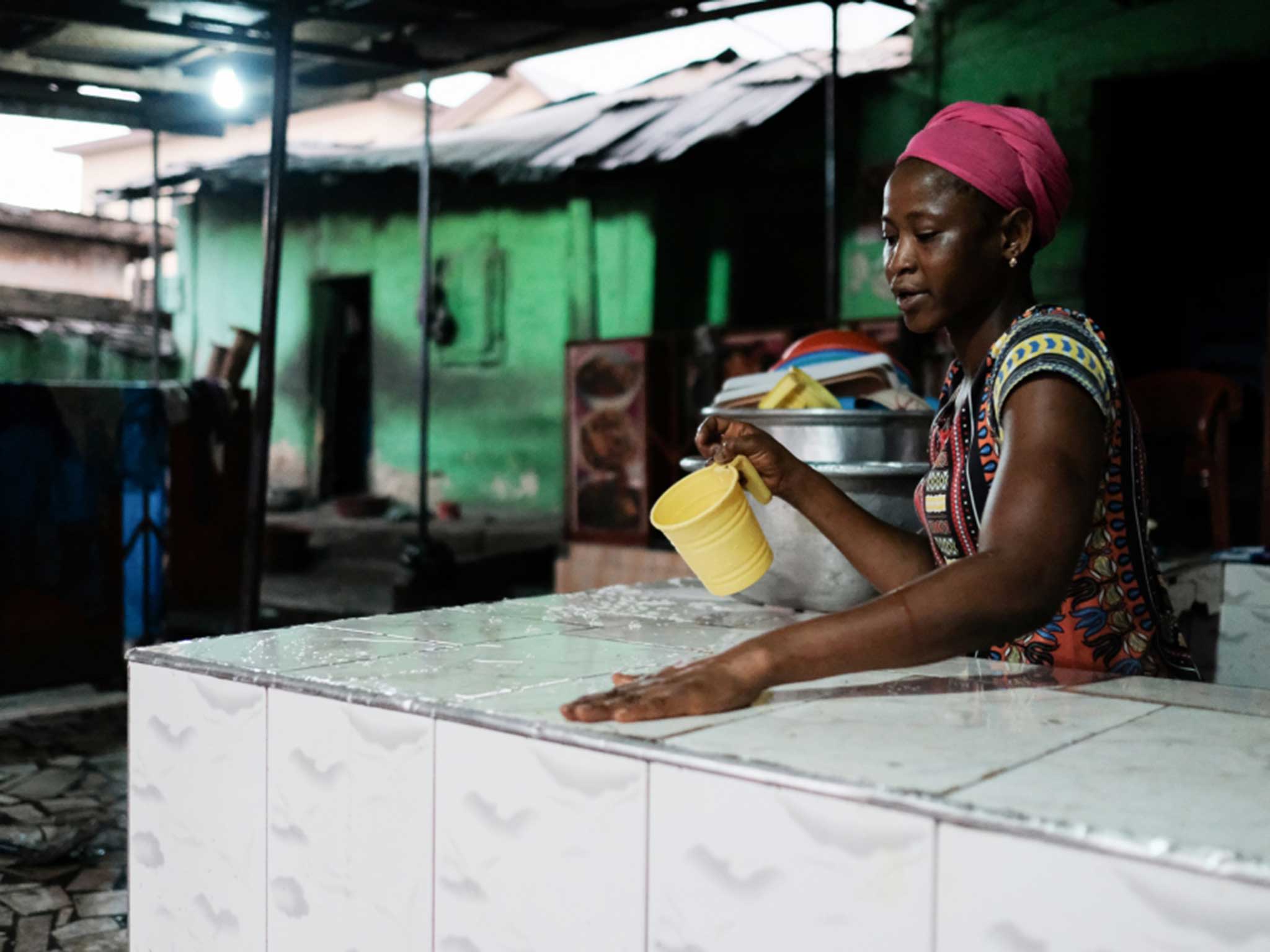
It is hot out, and apart from the occasional block of ice, there is nothing to keep the meat cold. Asante tries to keep it as fresh as possible: she keeps a bowl of iced blood handy to sprinkle on the cuts of meat – it makes them look freshly butchered, and the cold keeps the flies off. (After lunch, she will rinse her fingers in the bowl of blood.) Asante only butchers what she thinks she’ll sell immediately. If she sells out, she’ll have a porter bring more down from Atwemonom. It’s now about 9am. Asante will be here until six in the evening.
After that, any unsold meat will go back into the freezer at Atwemonom. Asante will pack up her stall, wash the blue plastic sheet and scrub the butcher’s block and the table again, ready for the next day. Up the hill at Atwemonom, the butchers will douse the fires in the burning area and wash the slaughter slab.
Dozens of miles away – in Barekese, the villages around Sunyani, and near Konongo – hunters will set out to bait traps. They’ll wait for nightfall, load their guns and head out into the bush.
A small fraction of the meat that passes through Kumasi’s Central Market will end up in suitcases, bound for other parts of the world (around 1 per cent of bushmeat actually leaves its country of origin).
While researchers have found strains of simian foamy virus in bushmeat smuggled into the USA, Ghana’s chief vet, Kikimoto, is adamant that very few pathogens could survive the trip. He argues that those that can, like anthrax spores, are rarely found on bushmeat. Still, personal shipments of fresh meat – bushmeat especially – are illegal in much of the world.
Ghanaian ex-pats and immigrants go to extraordinary lengths to take a taste of home back with them. The vast majority of this is legal: small quantities of fish, or dried cassava called gari, or a porridge mix known as Tom Brown (named after the Thomas Hughes novel, because it’s a favourite of Ghanaian children being sent off to boarding school for the first time).
More ambitious gourmets will cook, freeze and package the food so it survives six hours in the hold of a Boeing 747. Some even try to mask the smell. One grandmother, who forcibly stuffs her British grandchildren’s suitcases with stews and fried fish (and stops talking to them if they raise objections), lines the bags of food with a mixture of charcoal ash and camphor mothballs.
Should you wish to take some food back with you, you might be told it’s best to take a flight that arrives at a quiet time, when there are few customs agents about – like the Saturday night British Airways flight to London, which arrives early on Sunday morning.
When you’re leaving Ghana, airport security seem to be more worried about drugs and terrorism – they aren’t looking for food. Recently, I interviewed a man who, on his way back to the UK, got caught with a bag full of kenkey (a ball of sweet-sour fermented maize wrapped in corn husks and steamed). The Ghanaian police officer searching his bag looked up and said, “Don’t worry, I know the kenkey in London is very bad. Go and enjoy.”
This article was first published by Wellcome on Mosaic and on Quartz. It is reproduced here under a Creative Commons licence.
Join our commenting forum
Join thought-provoking conversations, follow other Independent readers and see their replies
Comments